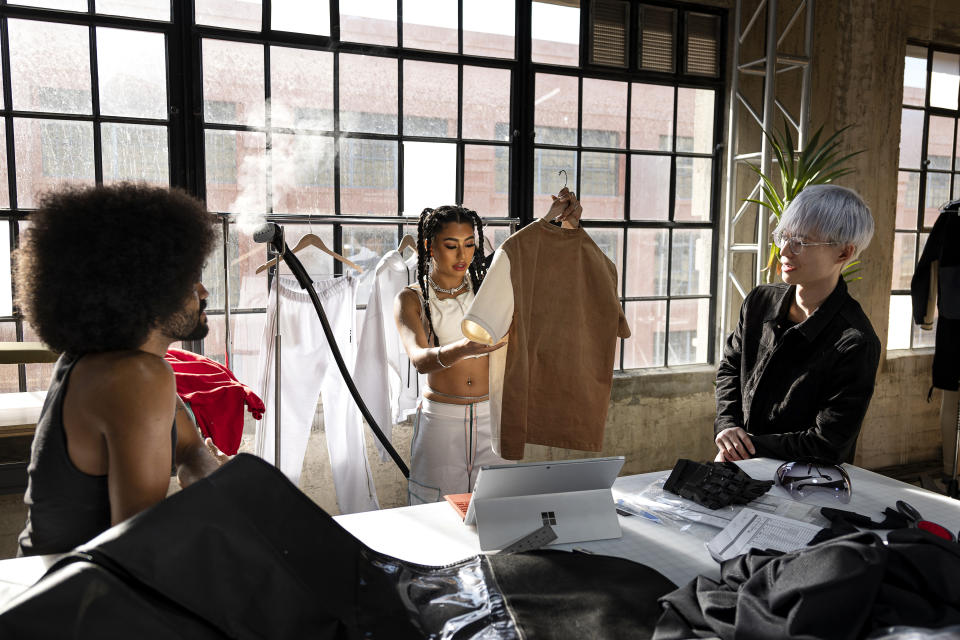How HBO Max’s ‘The Hype’ Offers a Modern Take on the Fashion Competition Show

Fashion competition shows have largely focused on the industry as a whole, but now HBO Max is giving a closer look at one of the more popular facets of fashion: the streetwear industry.
The streaming service debuted its new reality TV show “The Hype” on Thursday, bringing together 10 streetwear designers from across the country to Los Angeles to compete in challenges for the ultimate prize of $150,000 and a cosign from the show’s judges: rapper Offset; costume designer and stylist Marni Senofonte, and creative director and founder of Bephies Beauty Supply, Beth Birkett.
More from WWD
“I loved the fact that it was centered around streetwear and they were trying to do it differently,” Birkett said about why she wanted to be involved in the show. “Streetwear has always been a very male-dominated — specifically white-male-dominated — industry, so I like that ‘The Hype’ wanted to diversify with women, having women as the cosigners, and just mixing it up by showing the history of streetwear and that it did come from Black culture largely.”
The show’s diverse group of designers includes Justin Mensinger of Justin Mensinger, Timeekah “Murph” Murphy of Alani Taylor, Jolleson of Jolleson, Kai Nguyen of Lumiéres, Paije of Front Paije Design, Camila Romero of Deadblud, Blu of Wntd Apparel, Caroline Bentley Noble of Avenue C, Alan King of AKings and Wole Olosunde of Against Medical Advice.
Like other fashion competition shows, each week the contestants are given design challenges they are expected to finish in a short amount of time. They present their designs to the judges and the week’s guest judge and someone is crowned the week’s winner while another designer is eliminated. The weekly challenges have various prizes, including having the winning look featured on the homepage of StockX, which is one of the biggest streetwear resell sites.
The show has tapped a lengthy list of celebrities and figures in the fashion world to serve as guest judges, including Dapper Dan, Cardi B, Wiz Khalifa, Bobby Hundreds and Melody Ehsani, among others.
The show’s main logistical difference from other fashion competition shows is that the designers are creating a complete collection with their weekly challenges for a look book that is judged at the final round. While each week’s challenge is different, the designers have to create designs that meet the challenge’s expectation while fitting in with their overall collection.
“Even though the challenges were different every week, they were to challenge [the designers] to work within [their] own collection,” Senofonte said. “At the end of the show, you have a body of work and it’s not just a bunch of random stuff.”
Some of the show’s challenges include designing a jacket inspired by Los Angeles and the designers’ respective cultures, creating a look for an “It” couple and designing a custom look for a guest judge, rapper A$AP Ferg.

Courtesy of HBO Max
The A$AP Ferg challenge was the first the designers tackled, and the most frustrating for the judges to evaluate. In the episode, the rapper offers the designers the chance to ask him questions about his style, but none of the designers take up the opportunity.
“We have the coolest guy in front of [the designers] and none of them questioned him the way I would have if I had an artist in front of me when I first started out,” Senofonte said. “If I had to style someone and I had access to that exact person to speak to them, it would have made a world of a difference.”
Another challenge the judges had when critiquing the looks was focusing on the week’s challenge rather than judging the designer based on their entire body of work.
“The longer it went on the harder it was because you get to know the contestants and their story and it’s really hard sometimes to separate the story from the clothing,” Senofonte said. “Sometimes somebody has an off day and they performed so well [the last week] and you’ve seen their stuff, so the hardest part was just having to judge people on those off days.”
As streetwear is continuing to change and be at the forefront of fashion, the judges were looking for a winner who could also evolve with the industry’s changes.
“I’m looking for not just the most talented person, but the person that I feel is going to evolve streetwear and fashion and evolve clothing in a way we haven’t seen before,” Birkett said. “That’s what I’m most inspired by. I don’t like to see people that just do the same thing over and over. Someone with a good work ethic and attention to detail, but someone who knows how to evolve past who they are now and see the potential in that.”
On a deeper level, the judges see the show’s point of difference as the fact that it’s more representative of the fashion world and the world at large than other competition shows. The diverse group of designers come from various ethnic, social and economic backgrounds, which has always been a hallmark of the streetwear industry.
“[Streetwear] is a clear reflection of where we are now and where people are now,” Birkett said. “It reflects not just a certain group of people who have money to be in fashion. [The designers] take the simplest items like a T-shirt or hoodie and put these really dope details that reflect their cultural identity. It’s a reflection of art and art is a reflection of the times and the times are a very diverse culture.”
READ MORE FROM WWD HERE:
How the ‘Gossip Girl’ Reboot’s Fashion Is Different From the Original Series
Who Are the Real-Life Characters in the ‘House of Gucci’ Movie?
How ‘The Suicide Squad’ Translated DC Comics’ Villains to the Big Screen
Best of WWD
Sign up for WWD's Newsletter. For the latest news, follow us on Twitter, Facebook, and Instagram.

